Breutigam: Trompowsky Attack A45
1.d4
Nf6 2.Bg5
Ne4 3.h4
|

|
|
The move of the rook pawn may be markedly less played than 3.Bf4,
but as Martin Breutigam shows in his article, much
can be said in favour of 3.h4: in addition to
objective factors there is also the fact that it
wrenches opponents away from their accustomed
variations. |
Marin: Kovacevic Variation A48
1.d4
Nf6 2.Nf3 g6 3.e3 c5 4.dxc5
|
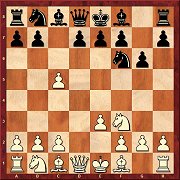
|
|
The surrender of the centre at first looks harmless,
but White will soon spread his wings on the queenside
with a3, b4 and c4. According to Mihail Marin a
future e3-e4 is even an option, whereas Black does
not find it easy to develop a clear plan. |
Rotstein: Snake Benoni A60
1.d4
Nf6 2.c4 c5 3.d5 e6 4.Nc3 exd5 5.cxd5
Bd6
|
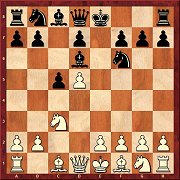
|
|
In the first section Arkadij Rotstein examines the
attempt at refutation with 6.e4 0-0 7.f4 and also the
possible deviations 6...Qe7 and 6...Be5. Then the author turns to the modern treatment with 6.Nf3 0-0 7.Bg5
Re8 8.e3
Bf8.
|
Schipkov: Dutch A88
1.d4 f5 2.c4
Nf6 3.Nf3 g6 4.g3
Bg7 5.Bg2 0-0 6.0-0 d6 7.Nc3 c6
|

|
|
In the final part of his series on 7...c6 Boris
Schipkov analyses continuations other than 8.d5 or
8.b3, for example this time he deals with 8.Qb3 and 8.Rb1.
But as our Russian author concludes, White does not
have a single variation with which he can achieve an
advantage. |
Postny: Caro-Kann B19
1.e4 c6 2.d4 d5 3.Nc3 dxe4 4.Nxe4
Bf5 5.Ng3
Bg6 6.h4 h6 7.Nf3
Nd7 8.h5
Bh7 9.Bd3
Bxd3 10.Qxd3 e6 11.Bd2
Ngf6 12.0-0-0
Be7 13.Kb1 0-0 14.Ne4
|
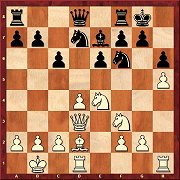
|
|
3.Nc3
may no longer be considered the main variation
nowadays (now it is 3.e5), but nevertheless theory
continues to develop and in some lines Black faces
problems. But according to Evgeny Postny he should be
in a position to be able to solve them. |
Kritz: Sicilian B35
1.e4 c5 2.Nf3
Nc6 3.d4 cxd4 4.Nxd4 g6 5.Nc3
Bg7 6.Be3
Nf6 7.Bc4 0-0 8.Bb3 a5
|
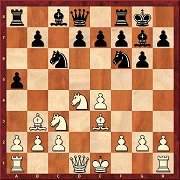
|
|
As the practice of this variation shows, players with
White commit a lot of inaccuracies. Leonid Kritz
straightens out matters somewhat and also shows how
the best moves for both sides lead to a slight
advantage for White. |
Langrock: French C01
1.e4 e6 2.d4 d5 3.Nc3
Bb4 4.exd5 exd5 5.Bd3
|

|
|
In the second part of this (for Black) unpleasant
version of a French Exchange, Hannes Langrock shows
variations in which after 5...Nc6 6.a3 Black does not take on c3. In addition the solid line 5...Nf6 is also up for discussion.
|
Neven: French C02
1.e4 e6 2.d4 d5 3.e5 c5 4.Nf3
Nc6 5.Bd3
|
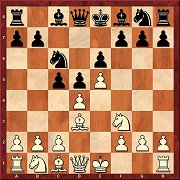
|
|
This is another variation in which players with Black
do not manage to reach the sort of positions with
which they are familiar. But that is White’s main
aim, because Knut Neven is not absolutely looking to
achieve an opening advantage with his repertoire
suggestion. |
Stohl: Slav D18
1.d4 d5 2.c4 c6 3.Nf3
Nf6 4.Nc3 dxc4 5.a4
Bf5 6.e3 e6 7.Bxc4
Bb4 8.0-0
|

|
|
Both after the more flexible 8...Nbd7 and after 8...0-0 the move 9.Nh4
is White’s most ambitious try. Igor Stohl examines
the latest developments, but cannot see a way for
White to achieve a secure advantage. |
Krasenkow: Semi-Slav D30
1.d4 d5 2.c4 e6 3.Nf3 c6 4.Qc2
|
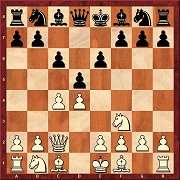
|
|
From the practical point of view, the queen move is
not a bad one, since the best move 4...dxc4 is played
only in a minority of games. But after 5.Qxc4
Nf6 the analyses of Michal Krasenkow show that in this case White has good prospects.
|
Grivas: Queen’s Gambit D43
1.d4 d5 2.c4 c6 3.Nf3
Nf6 4.Nc3 e6 5.Bg5 h6 6.Bxf6
Qxf6 7.Qb3
|

|
|
The move of the white queen represents a promising
way of nevertheless getting in e4 in a single move.
The results of the analysis of Efstratios Grivas hint
that White always possesses at least a
mini-advantage. |
Karolyi: Nimzo-Indian E32
1.d4
Nf6 2.c4 e6 3.Nc3
Bb4 4.Qc2 0-0 5.a3
Bxc3+ 6.Qxc3 b5
|

|
|
This pawn sacrifice can be recommended to those
players with Black who want to be active right from
the opening. White is well advised not to hang on to
the pawn. But even when he returns it, according to
Tibor Karolyi he has few prospects of achieving an
advantage. |
Kuzmin: King’s Indian E61
1.d4
Nf6 2.c4 g6 3.Nc3
Bg7 4.Bg5 d6 5.e3 0-0 6.Be2
|
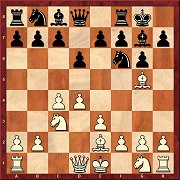
|
|
Vassily Smyslov liked to play 4.Bg5
and so did Mikhail Gurevich later. In the first part
of his contribution Alexey Kuzmin investigates lines
in which Black has already played ...d6. White can
then harbour justified hopes of an advantage.
|